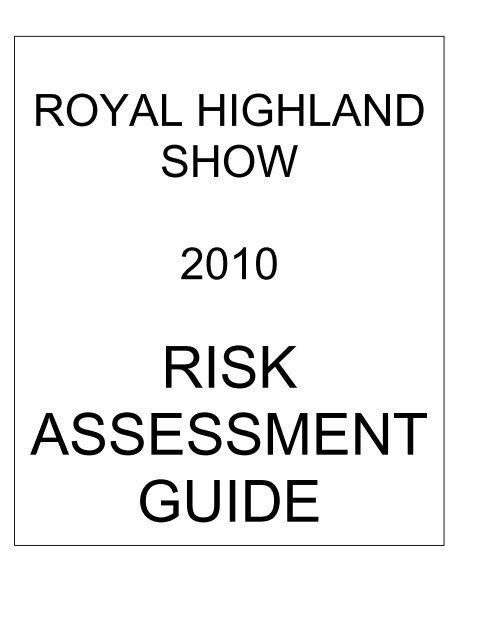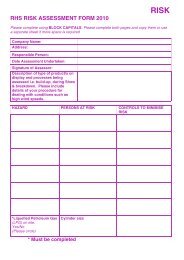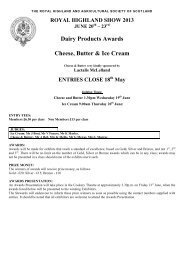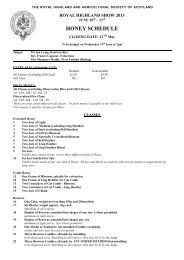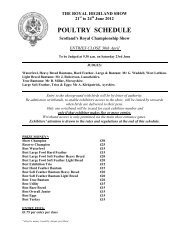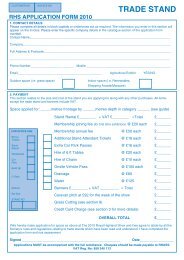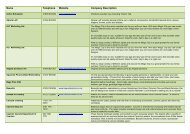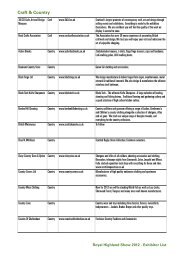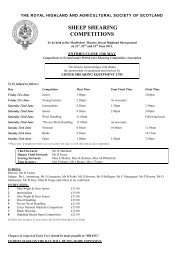general risk assessment guidance notes - Royal Highland Show
general risk assessment guidance notes - Royal Highland Show
general risk assessment guidance notes - Royal Highland Show
Create successful ePaper yourself
Turn your PDF publications into a flip-book with our unique Google optimized e-Paper software.
ROYAL HIGHLANDSHOW2010RISKASSESSMENTGUIDE
GENERAL RISK ASSESSMENTGUIDANCE NOTESALL completed <strong>risk</strong> <strong>assessment</strong>s must contain the following information:- Name, address and contact details for the company as well as the appointed contact.- Description of the activity you will be undertaking or the exhibit you will be displayingduring the show.- Details of all the <strong>risk</strong>s, who might be harmed and your control measures associated withthe build up of the stand, the activity or display undertaken during the show and thebreak down of the stand.The following guidelines will provide you with some examples you should consider when youcomplete a <strong>risk</strong> <strong>assessment</strong>.Company Name:Address:Responsible Person:Date Assessment Undertaken:( completion date of form)Signature of Assessor:(someone in the company who decides if thereare any <strong>risk</strong>s)Description of type of product/s ondisplay and processes beingassessed ie buildup, during <strong>Show</strong>,breakdownSomething Ltd.Some HouseLong StreetSomewherePX00 0PXMr Joe Bloggs12th December 2006Mr Joe BloggsAgricultural Machinery ie plough – Offloading andloading using hiab. Safe layout of machinery withoutany obvious trip hazards.HAZARD PERSONS AT RISK CONTROLS TOMINIMISE RISKSlipping/ tripping General Public, staff Covered possible trip hazardor highlighted it withVehicle movement(eg forklift, HGV)Electrical items (eg TV)General Public, staffStaff, operators, cleaners,contractorsfluorescent tapeProvided appropriate trainingof vehicle.Maintenance carried out onvehicle and where appropriatestatutory thoroughexaminations.Used a certified electrician toPAT test equipment andelectrical supply tested.
Machinery beingunloaded/loaded fromHGV/TrailerStaff, operators, contractors Trained staff used to operatemachinery. Keep area clearwhen moving machinery on tostand. Use second/thirdperson to guide vehicle – fromsafe distance.Raised Hydraulics General Public, staff Lock Hydraulic rams withangle Iron staysKeys removed and brakes lefton.Static Machinery during General Public, staffshowManual Handling Staff, operators, contractors Provided appropriate training.Heavy loads split, trolleysused or carried jointly.Working at Heights Staff, operators, contractors Provided appropriate training.Appropriate equipment used.E.g. scaffolding, cherry picker,netting, edge protection,ladders & harness (ladders tobe checked prior to use andfooted by second person,access required for short timeonly and three point contactable to maintained withladder).*Liquefied Petroleum Gas(LPG) on site. Yes/No(Please circle)Cylinder sizeAdequate training andinstructionFIRE RISK ASSESSMENTGUIDANCE NOTESThe following guidelines will provide you with some examples you should consider whenyou complete a Fire <strong>risk</strong> <strong>assessment</strong>HAZARD PERSONS AT RISK CONTROLS TO MINIMISERISKLook only for hazards, whichcould reasonably result in a fireor injury to persons if a fire wereto start. Use the followingexamples as guidelines.There is no need to listindividuals by name – justthink about groups of peopledoing similar work or whomay be affected, forexample:For the Hazards listed, havesufficient measures already beentaken to reduce the <strong>risk</strong>, or areadditional controls required?
Ignition Sources ie. naked flame,electrical equipment, hot plates.Electrical equipment – Is it wellmaintained and are staff trainedin its use?Trailing cables/extension leadsSmokingCombustible materials ie rubbish,waste, wood, cardboard.Storage of combustible materialGas cylinder storageMembers of the public, andparticularly childrenMaintenance personnelOperatorsCleanersStaff and members of thepublic with disabilitiesPay particular attention to: Inexperienced Staff Lone WorkersAdequate Fire Escapes forbuildings and Marquees.Provision of appropriate fireextinguishers.Control measures should be‘reasonably practicable’ i.e.reduce the <strong>risk</strong> without entailingexcessive costs and time for littleor no benefit. State controlmeasures after each hazard.Do the precautions already taken: Meet the standards set bylegal requirements? Comply with recognisedindustry standard? Reduce the <strong>risk</strong> as far asreasonably practicable?Have you provided: Adequate information,instruction and training? Adequate systems orprocedures?Do staff know what to do in theevent of a fire?If so, then <strong>risk</strong>s are adequatelycontrolled. The precautionstaken need to be indicated in thecontrols column.Where the <strong>risk</strong> is not adequatelycontrolled, indicate what moreyou need to doTHE ROYAL BANK OF SCOTLANDMENTOR SERVICES:RISK MANAGEMENTGUIDANCE NOTES & FACTSHEETS
IntroductionThe following guide explains the principles and practice of Occupational Health & Safety<strong>risk</strong> <strong>assessment</strong> and why it is necessary. Organisations will tailor the approachdescribed here to match their own needs, taking into account the nature of their workand the seriousness and complexity of their <strong>risk</strong>s. Planning and implementing <strong>risk</strong><strong>assessment</strong> and <strong>risk</strong> control programmes is covered later in this guide.Key termsThe key terms are:A hazard is a source of potential harm or damage or a situation with potential for harmor damage;A <strong>risk</strong> is the combination of the likelihood and the consequences of a specifiedhazardous event (accident or incident). A <strong>risk</strong>, then, always has two elements:the likelihood that a hazard may occur;the consequences of the hazardous event.When to use the <strong>risk</strong> <strong>assessment</strong> procedureAll employers and self employed people have a legal duty to assess the <strong>risk</strong>s from theirwork activities. The <strong>risk</strong> <strong>assessment</strong> procedure described in this guide is intended to beused:for situations where hazards appear to pose a significant threat and it is uncertainwhether existing or planned controls are adequate in principle or in practice;by organisations seeking continuous improvement in their Occupational Health &Safety management systems, in excess of minimum legal requirements.The <strong>risk</strong> procedure described in this guide is NOT necessary or cost-effective when it isquite clear from preliminary study that <strong>risk</strong>s are trivial, or a previous <strong>assessment</strong> hasshown that existing or planned controls:conform to well-established legal requirements or standards;are appropriate for the tasks;*are, or will be, understood and used by everyone concerned.Here no further action is required other than to ensure, where appropriate, that controlscontinueConducting Risk AssessmentsThe Management of Health and Safety at Work Regulations 1999 supplements therequirements of the Health and Safety at Work etc Act 1974 by extending the employers
obligations to develop a <strong>general</strong> framework for safety management and enhance anycontrol measures provided.The main provision of the Regulations is the need for an employer to conduct <strong>risk</strong><strong>assessment</strong>s of his work activities and to identify the action needed to control the healthand safety <strong>risk</strong>s in the workplace.The <strong>assessment</strong> of hazardous operations will not just be a paper exercise divertingscarce management resources from the business of managing. It will be a practicalexercise taking the opportunity to review and evaluate operations and seekimprovements.What is Risk Assessment?A hazard is something which has the potential to cause harm, e.g., a substance,machine or situation, such as working at heights. A <strong>risk</strong> is the likelihood that the harmwill occur combined with its severity (i.e., the number of people likely to be affected andwhether the hazard would cause minor or major injuries or even a fatality). Risk<strong>assessment</strong> is an evaluation of the chance that harm will occur.Conducting Risk Assessments1) Hazard spotting -Appoint a small group (usually 3 persons) to walk round theworkplace and look at what could cause harm, concentrating on significant hazardswhich could have severe consequences.During the walk round ask employees for their opinions and what they consider to besignificant. The use of accidents/ill health records and manufacturers' instruction/ datasheets can aid in your hazard spotting.2) Decide who might be harmed and how. You need to consider not only employees butalso people who may not always be present in the workplace, e.g., cleaners, visitors,delivery personnel, contractors, maintenance workers, etc.3) Decide for each hazard whether the <strong>risk</strong> is high, medium, low or not significant. Haveyou done everything that the law says you have to? Are industry standards in place?The law says that you must do what is reasonably practicable to keep your workplacesafe.Improving health and safety need not necessarily cost a lot. Some control measures arevery simply implemented with no major restraints on budget. For example, non-slipmaterial on slippery steps.Ask yourself whether you can get rid of the hazard altogether or, if not, how you cancontrol the <strong>risk</strong> so that harm is unlikely.Generally, personal protective equipment will only be used when there is nothing elsereasonably practicable.Preventive and protective measures will be implemented as a result of the <strong>assessment</strong>and these could include such items as avoidance of a <strong>risk</strong> by elimination or reduction
(e.g., buying in dangerous substances in a lesser quantity) or combating a <strong>risk</strong> at source(e.g., removing spillages from floor areas rather than introducing warning signs).4) The legal requirement is to record the significant findings of a <strong>risk</strong> <strong>assessment</strong>. Thesewill include a list of hazards identified in the <strong>assessment</strong>, highlighting the types ofpeople who may be at <strong>risk</strong>. Existing control measures will be identified, if they are inplace.It is necessary to indicate that all <strong>risk</strong>s have been assessed, but only records of those<strong>risk</strong>s assessed as significant need to be kept.The prime objective of recording an <strong>assessment</strong> is to indicate that it was done soundly,addressed the significant issues and came to justifiable conclusions. The amount ofeffort put into recording will be related to the degree of <strong>risk</strong> and the complexity of theissues involved. The records will also serve purposes that are worthwhile, such as toenable management to identify:the basis for monitoring health and safety controlstraining programmes neededthe standards against which unusual events are judgedchanges which make re-<strong>assessment</strong> necessary.5) From time to time review your <strong>assessment</strong>s and revise as necessary. Fresh hazardswill arise from the introduction of new machines, substances and procedures.Significant changes will be added to <strong>assessment</strong>s to take account of new hazards.There is no need to amend your <strong>assessment</strong>s for trivial changes but new hazards willbecome apparent and thus you will have a need to review your <strong>assessment</strong>saccordingly.The review process will be undertaken at least once every five years, or more often ifthings change or if the <strong>risk</strong>s are high.6) Make sure that all employees are made aware of the <strong>risk</strong> <strong>assessment</strong>s and theircommensurate control measures via training and communication. Keep a record of allsuch sessions.Key Action StepsLook for the hazards by making a workplace inspection.Decide who might be harmed and why.Consider the <strong>risk</strong>s arising from the hazards and decide whether existingarrangements are adequate.Make written records of your findings.Carry out periodic reviews of your <strong>assessment</strong>s and make necessary revisions.Share the findings of the <strong>assessment</strong>s -and the control measures -with youremployees.
ReferencesINDG 163L Five steps to <strong>risk</strong> <strong>assessment</strong>L21 The Management of Health and Safety at Work Regulations 1999 (as amended)--------------------------------------------------Useful websites:The Health and Safety Executive - www.hse.gov.uk(Or specifically the agricultural section www.hse.gov.uk/agriculture)Edinburgh Council - www.edinburgh.gov.ukRBS Mentor Services – www.rbsmentor.co.ukInfo Scotland – www.infoscotland.co.uk<strong>Royal</strong> <strong>Highland</strong> <strong>Show</strong>; Trade section – www.royalhighlandshow.org/trade


